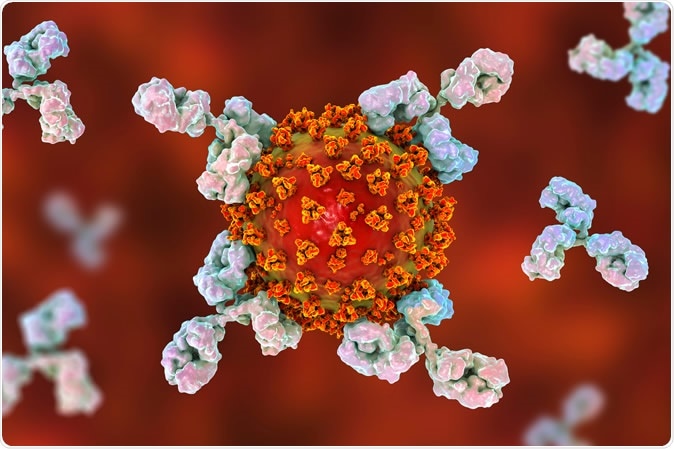According to the statement from the Director-General of WHO, Tedros Adhanom Ghebreyesus, about the global pandemic of COVID-19, the worst is far from over, as immunity to the infection in the form of antibodies is present in only around 2 to 3 percent of the population.
What does this mean?
There were initial theories of herd immunity. If a large population is infected (over 80 percent), it is speculated that the whole population or community will develop immunity against the infection due to the antibodies present in those who are already infected. The same was speculated initially for COVID-19, and it was felt that those with high titers of antibodies against the infection could carry an “immunity passport.” Their plasma containing the antibodies could also help those with an active infection.

Antibodies attacking SARS-CoV-2 virus, the conceptual 3D illustration. Image Credit: Kateryna Kon / Shutterstock
No long term protection
The WHO says that because only a meager few individuals carry the antibodies, they may not be enough to provide herd immunity to the whole population. Since this is not possible, the WHO officials say, return to normal life could be delayed. They also emphasize that there is no long term protection offered by the infection in the form of antibodies. This could mean that a person who has recovered from the infection carried a risk of being infected again.
End in sight?
A few days back, the WHO said that unless a vaccine is developed, there could be no escape from social distancing practices at present. They also said that a vaccine could only be a reality in only around a year to 18 months.
One of the WHO experts said that there is no data at present that shows that this form of herd immunity could be a reality and those who have recovered could be immune from the disease.
Expert speak
The Director-General said on Monday that 2 to 3 percent is a ballpark figure of the population who are immune to the disease. He said that these are based on the studies conducted by various agencies and supported by the WHO.
According to Maria Van Kerkhove, the WHO’s technical lead on COVID-19 added that these figures were much less than what was expected. She added that some countries such as United States, United Kingdom, Germany, and Italy are looking at the development of immunity passports. This may not be immediately possible, she said.
Van Kerkhove said, “Right now, we have no evidence that the use of a serological test can show that an individual has immunity or is protected from reinfection.” She explained that serological tests are blood tests that look for antibodies against a specific infection. She added, “These antibody tests will be able to measure that level of seroprevalence – that level of antibodies, but that does not mean that somebody with antibodies means that they are immune.”
Dr. Michael Ryan, a colleague of Van Kerkhove, also said, “There are serious ethical issues around the use of such an approach, and we need to address it very carefully, we also need to look at the length of protection that antibodies might give. You might have someone who believes they are seropositive (have been infected) and protected in a situation where they may be exposed, and in fact, they are susceptible to the disease.”
Anthony Fauci, the top US infectious-disease expert, had said earlier that he was “willing to bet anything that people who recover are protected against reinfection.” These antibodies containing plasma could also help those with active disease believed experts.
Dr. Tedros Adhanom Ghebreyesus, in a Geneva press meet, said, “Easing restrictions is not the end of the epidemic in any country. So-called lockdowns can help to take the heat out of a country’s epidemic.” “Early data suggests that a relatively small percentage of the populations may have been infected,” Dr. Tedros said. “Not more than 2 to 3 percent.”
Tedros explained that while he did not negate the utility of antibody tests at present, these tests should be taken along with other tests to check for active infection. He said that the WHO still supported antibody tests that could help researchers “understand the extent of infection in the population.”
Relevant studies
Stanford University researchers recently have revealed results of their study which showed that those who had been infected with the virus were 85 times more than what was officially reported. This was based on the antibody titers. Santa Clara County had between 48,000 and 81,000 infected persons and most of these patients did not show any symptoms. This was around 3 percent of the population. A study from the Netherlands also showed that 3 percent of the population had antibodies against the virus. China too has reported that 3 percent of the population had antibodies against the infection.